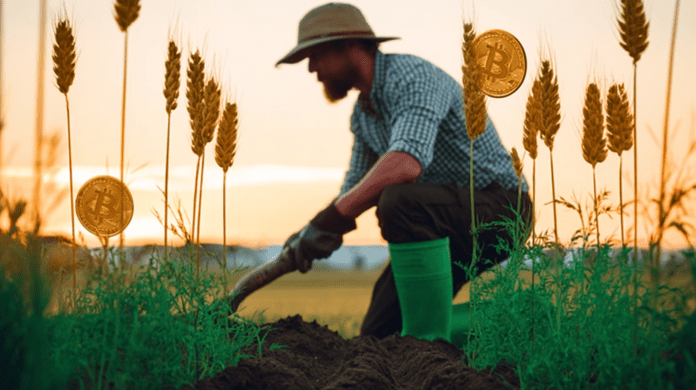Decentralized finance has revolutionized how people interact with digital assets, creating opportunities that traditional banking systems simply cannot match. Among the most talked-about innovations in this space, yield farming stands out as a method that promises attractive returns while simultaneously supporting blockchain ecosystems. For those willing to navigate its complexities, this practice offers potential rewards that far exceed conventional savings accounts, though not without considerable risks that demand careful consideration.
What Is Yield Farming in Crypto
Understanding the fundamentals provides essential context before exploring advanced strategies and platform selection.
Definition of Yield Farming
What is yield farming at its essence? It’s a strategy where cryptocurrency holders lock their digital assets into decentralized finance protocols to earn rewards. Yield farm crypto operations involve providing liquidity to various platforms, which then compensate participants with transaction fees, governance tokens, or interest payments. What is crypto yield farming fundamentally about is maximizing returns by strategically deploying capital across different protocols and constantly seeking the highest available yields.
History and Evolution of Yield Farming
The concept gained massive traction in 2020 during what became known as “DeFi Summer,” when platforms began offering governance tokens to liquidity providers. This innovation transformed passive holding into active participation, with early adopters earning extraordinary returns. Since then, yieldfarming has matured from an experimental practice into a sophisticated investment strategy with established protocols and refined methodologies.
How Yield Farming Works
Grasping the technical mechanisms helps participants make informed decisions and avoid costly mistakes.
Liquidity Pools and Automated Market Makers (AMMs)
At the heart of crypto yield farming lie liquidity pools—smart contracts holding paired cryptocurrency deposits. Users contribute equal values of two tokens to these pools, enabling decentralized trading without traditional order books. An automated market maker (AMM) uses algorithmic pricing formulas to facilitate trades, with liquidity providers earning a portion of transaction fees generated by the pool.
Role of Smart Contracts
Smart contracts automate the entire yield farming process, eliminating intermediaries while executing predetermined rules transparently. These self-executing agreements manage deposits, calculate rewards, and distribute earnings without human intervention. However, this automation introduces smart contract risks, as coding errors or malicious exploits can lead to catastrophic losses.
Rewards and Interest Mechanisms
Yield farming rewards come from multiple sources depending on the platform and strategy. Transaction fees represent the most straightforward compensation, where liquidity providers receive a percentage of trading activity. Many protocols also distribute native governance tokens as additional incentives, creating opportunities for compounding returns. Interest payments from lending protocols offer another revenue stream for those participating in credit markets.
Popular Yield Farming Strategies
Different approaches suit various risk tolerances and capital availability.
Liquidity Provision on DEXs
Providing liquidity to decentralized exchanges represents the most common yield farming strategy. Participants deposit token pairs into pools, earning fees from traders who use that liquidity. High yield farming platforms often attract larger deposits by offering competitive fee structures and additional token incentives.
Staking vs Yield Farming
While often confused, staking vs yield farming involves distinct mechanisms. Staking requires locking tokens to support network security on proof-of-stake blockchains, earning predictable rewards with minimal active management. Yield farming demands more hands-on involvement, constantly evaluating opportunities across multiple protocols while managing exposure to impermanent loss and other risks.
Lending and Borrowing Protocols
Lending protocols allow users to deposit cryptocurrencies that borrowers can access by providing collateral. Lenders earn interest on deposited assets, while borrowers pay fees for access to capital. This creates sustainable passive income crypto opportunities with generally lower risk profiles compared to liquidity provision strategies.
Major Yield Farming Platforms
Several established protocols dominate the DeFi yield farming landscape, each offering unique features and opportunities.
Uniswap
As the largest decentralized exchange, Uniswap pioneered the automated market maker model that underlies modern yield farming. Liquidity providers earn 0.3% of trading volume in their chosen pools, with the platform’s massive trading activity generating substantial fee income for participants.
Aave
This leading lending protocol enables users to deposit assets and earn interest while borrowers access those funds. Aave’s innovative features include flash loans and rate switching, creating diverse yield farming crypto opportunities beyond simple liquidity provision.
Curve Finance and Others
Curve Finance specializes in stablecoin trading with minimal slippage, making it popular for conservative yield farmers seeking lower volatility. Other notable platforms include Compound, SushiSwap, and Balancer, each offering distinct mechanisms and reward structures that appeal to different participant profiles.
Benefits of Yield Farming
When executed properly, this strategy offers compelling advantages over traditional investment approaches.
Passive Income Opportunities
DeFi yield allows cryptocurrency holders to generate returns on otherwise idle assets. Rather than simply holding tokens hoping for price appreciation, yield farmers earn continuous income through fees and rewards. Successful practitioners treat their holdings as productive capital, constantly working to generate cash flow.
Portfolio Diversification
Yield farming crypto strategies enable diversification across multiple protocols, token types, and risk profiles. This spread reduces concentration risk while exposing participants to various sectors within the decentralized finance ecosystem. Strategic allocation across different platforms and asset classes creates more resilient portfolios capable of weathering market turbulence.
Risks of Yield Farming

Honest assessment of potential downsides prevents catastrophic losses and sets realistic expectations.
Impermanent Loss
Impermanent loss occurs when token prices diverge significantly from their initial ratio in a liquidity pool. Liquidity providers may end up with less total value than if they had simply held the original tokens. This phenomenon affects all automated market maker pools, with volatility increasing potential losses. Understanding and calculating this risk forms a crucial component of any crypto farming guide.
Smart Contract Vulnerabilities
Code exploits represent existential threats to yield farming operations. Hackers continuously probe protocols for vulnerabilities, occasionally succeeding in draining millions of dollars. Even audited contracts carry risks, as complex interactions between multiple protocols can create unforeseen attack vectors. Smart contract risks necessitate careful platform selection and avoiding protocols with unproven track records.
Market Volatility and Rug Pulls
Cryptocurrency markets experience extreme price swings that can quickly erase yield farming profits. Sudden crashes expose participants to liquidations in leveraged positions or devastating impermanent loss scenarios. Rug pulls—where project teams abandon protocols after collecting user deposits—pose additional threats, particularly on newer platforms promising unrealistic returns.
Yield Farming vs Other Crypto Earning Methods
Comparing different strategies helps identify which approaches align with individual goals and risk tolerance.
Yield Farming vs Staking
How does yield farming work compared to staking? Staking offers simplicity and predictability, requiring minimal active management while providing steady returns. Yield farming demands constant monitoring and position rebalancing but potentially delivers higher yields. Bitcoin yield farming remains largely unavailable since Bitcoin uses proof-of-work consensus, though wrapped Bitcoin enables participation in DeFi protocols.
Yield Farming vs Liquidity Mining
These terms often appear interchangeable, though subtle distinctions exist. Liquidity mining specifically refers to earning governance token rewards for providing liquidity, while yield farming encompasses broader strategies including lending and more complex multi-protocol approaches. Both fall under the defi yield umbrella and share similar risk profiles.
How to Start Yield Farming
Practical guidance helps newcomers navigate the technical and strategic aspects of getting started.
Choosing a Platform
Platform selection should prioritize security, track record, and transparent operations. Established protocols with extensive audits and proven longevity generally offer safer entry points than newer projects promising extraordinary yields. Research team backgrounds, audit reports, and community sentiment before committing capital.
Selecting Tokens and Pools
Yield farming strategies vary dramatically in risk and potential returns. Stablecoin pairs offer lower volatility but typically generate modest yields. Volatile token pairs promise higher rewards but expose participants to significant impermanent loss. Beginners should start with established tokens and conservative pools before exploring higher-risk opportunities.
Risk Management Tips
Never invest more than you can afford to lose completely. Diversify across multiple platforms and strategies rather than concentrating everything in a single pool. Start small to understand mechanics and identify potential issues before scaling up. Regularly harvest rewards and rebalance positions to maintain desired risk exposure.
Future of Yield Farming

Industry evolution will shape the long-term viability and structure of yield farming operations.
Emerging Trends and Innovations
Cross-chain yield farming enables participants to access opportunities across multiple blockchain networks, increasing available options and potential returns. Layer-2 scaling solutions reduce transaction costs that previously made small-scale farming unprofitable. Institutional participation continues growing, bringing additional liquidity and credibility to established protocols.
Regulatory Considerations
Government scrutiny of decentralized finance intensifies as the sector matures and attracts mainstream attention. Future regulations may impact how yield farming operates, potentially requiring identity verification or limiting participation in certain jurisdictions. Staying informed about regulatory developments helps participants adapt strategies and maintain compliance.
Conclusion: Is Yield Farming Worth It?
Yield farming presents genuine opportunities for earning substantial returns on cryptocurrency holdings, but it’s far from a risk-free proposition. What is yield farming crypto ultimately about? It’s a sophisticated strategy that rewards knowledge, diligence, and risk management while punishing carelessness and greed. Those willing to invest time understanding protocols, monitoring positions, and accepting potential losses may find yield farm opportunities compelling. However, newcomers should approach cautiously, starting with small amounts on established platforms while building expertise. The yfarm money crypto potential exists, but only for those who respect the risks and commit to continuous learning. Yield farming explained simply: it’s high-risk, high-reward activity that demands active participation and constant vigilance in exchange for potentially superior returns compared to traditional crypto holding strategies.

